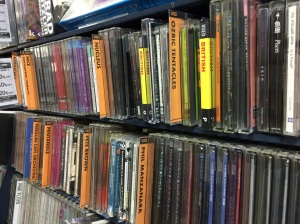
Disk Union organizes its prog CDs by country. How cool is that.
Not only that, but artists within a country are filed next to the proper supergroup. So the Genesis shelf is where you’ll find Tony Banks and Anthony Phillips, while the Yes shelf includes Peter Banks, Badger (which includes Tony Kaye), and White, the band fronted by drummer Alan White.
The links run deep. The King Crimson section included Bill Bruford’s jazz band Earthworks and the colossal Centipede, whose more-than-50 members happen to include Keith Tippett.
 This comes up because yes, I’ve just taken a trip to Japan, and my first-ever visit to Disk Union was a highlight. I think of the store as a colony creature, a sprawl of genre-specific ministores spread across a few Shinjuku blocks, with satellites around the city and in the suburbs. The “main” store occupies all seven floors of one building, with one specialty per floor. Prog was on Floor 3.
This comes up because yes, I’ve just taken a trip to Japan, and my first-ever visit to Disk Union was a highlight. I think of the store as a colony creature, a sprawl of genre-specific ministores spread across a few Shinjuku blocks, with satellites around the city and in the suburbs. The “main” store occupies all seven floors of one building, with one specialty per floor. Prog was on Floor 3.
Other parts of Disk Union occupy random floors of other buildings on the same street. Jazz, for example, is on a ground floor at the end of the block.
Most at of my time was spent in the Prog section. I went farther upstairs to check out indie rock and ’80s, bypassing the classic rock floor, where they were playing the Sgt. Pepper album. (Each store/floor plays its own relevant music. I love The Beatles, but my taste for classic rock has waned.) I also peeked at the 7th Floor punk section — where the clerk was playing a Japanese band that was basically indie rock with ragged, screaming vocals. It was an odd breed of punk, but it was a good antidote to the sugary Japanese pop that I’d been hearing for the entire trip.
The punk section seemed legit, by the way. Sub genres included power-pop-punk, melodic punk, harder stuff bordering on metal (the proper Metal store is in another building), and classic ’70s/’80s acts, including plenty from Japan.
My haul from Disk Union was entirely prog: the aforementioned White and Centipede albums; a ’70s British band called Gryphon, which is what the clerk was playing as I shopped; and a Japanese band called Asturia, selected after I pressed the clerk for a recommendation.
What these things have in common is that I’d never encountered them at home. CDs are a pricey luxury in Japan, running at ¥2500 or ¥3000 ($25 to $30) for new titles, so there wasn’t much leeway for the novelty of a “J”-version of a known quantity. I was also more hesitant than normal when it came to taking a chance on a random title.
The price is also why I didn’t buy from the Jazz store. The small avant-garde section was robust, but the titles were mostly familiar; they either originated in the States or could be easily obtained there. Too bad — an avant-jazz bin used to be a treasured find, but the Internet’s trove of news has made surprises harder to come by. That’s the downside to having access to such online riches.
 So many of the musicians I came to know during the early 2000s have fled to New York. Among them is drummer
So many of the musicians I came to know during the early 2000s have fled to New York. Among them is drummer  The most recent live music show I’ve seen (not counting the
The most recent live music show I’ve seen (not counting the  The second set was by local stalwarts Grex, this time in basic trio format: Karl Evangelsta on guitar, Rei Scampvia Evangelista on keyboards, and Robert Lopez on drums.
The second set was by local stalwarts Grex, this time in basic trio format: Karl Evangelsta on guitar, Rei Scampvia Evangelista on keyboards, and Robert Lopez on drums.
 The newest
The newest  I always considered radio DJ’ing to be a kind of performance. Certainly lesser than actually performing on a musical instrument, but it did require attention to rhythm, balance, and audience.
I always considered radio DJ’ing to be a kind of performance. Certainly lesser than actually performing on a musical instrument, but it did require attention to rhythm, balance, and audience.